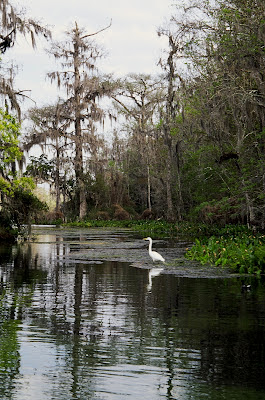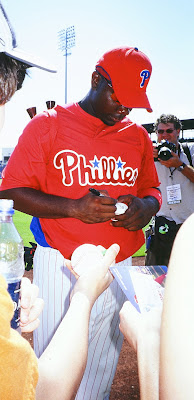A prehistoric beast prowls the depths of a remote jungle, preying upon visiting scientists in Hollywood’s Creature From the Black Lagoon. I’m about to discover the secrets of this primeval forest on a tour of Florida’s Wakulla River, which doubled for The Amazon in the 1954 film.
The last tour of the day is about to depart when I arrive at Wakulla Springs State Park late in the afternoon. I hurry to the dock and take my seat on the flat-bottomed boat, along with 10 other tourists.
Our park ranger points to wildlife along the shore as we trawl the river. Bird life is abundant, including these species: great egrets, blue herons, moorhens, anhingas, wood ducks, black vultures, white ibis, green herons, cormorants, widgeons and hooded mergansers. The river is also home to reptiles and we spot alligators and turtles sunning themselves on partially submerged logs.
 |
| An Anhinga perches in the dense vegetation along the riverbank. |
 |
| Reptilian resident of the Wakulla River. |
The boat enters a narrow channel where moss drips from tropical vegetation. Old growth cypress trees—some of them 400-600 years of age—line the riverbanks. Movie scenes were filmed here and the area has an eerie, sinister feel, as if the monster could be lurking nearby.
 |
| No, it's not The Creature—a Great Egret graces the swamp. |
The ranger impresses us with these facts on this fun and educational tour:
The Wakulla is fed entirely by a spring 185 feet below the ground which gushes from the earth at the incredible rate of ~400,000 gallons per minute; divers have been exploring the spring beneath the river and have discovered a series of underwater caves 385 feet deep and 4 miles long.
****
****
After the tour I check into my room in the old Ed Ball Lodge. The lodge was built in 1937 and is definitely showing its age. Kind of dark and spooky, a la Stephen King’s The Shining, but it should be OK for one night.
In the lobby I discover the genuine—not cinematic—creature from the Black Lagoon, a large alligator specimen with a sad but interesting story: Affectionately known as “Old Joe” the alligator was of undetermined age (some say he was 300 years old), over 11 feet long and 650 pounds, and he lived on a sand bar in the Wakulla River across from the park’s swimming area. “Old Joe” never hurt anyone and was considered a part of the family by those who worked in the park.
Tragically, “Old Joe” was murdered on the night of August 1, 1966; State Park personnel found his body the next morning, shot between the eyes and floating in the lagoon outside the swimming area. Presumably he was too heavy to fit into the poacher’s boat. The Audubon Society and The Wakulla Springs Foundation offered a $5,000 reward for information on his murder but the killer was never found. Who knows? Perhaps, in a turn of poetic justice, “Old Joe’s” murderer met his fate at the hands of Hollywood’s mythical swamp beast.
For more information on this fascinating Florida park run, don't walk, to this website:
http://www.floridastateparks.org/wakullasprings/aboutthepark.cfm
****
I've just been reminded by a fellow blogger that today is the first anniversary of this blog. Vickie Bates and I, along with 13 other hopeful bloggers, signed up for a Spring 2011 beginning blogging class with Media Bistro. As of today, only Vickie and I remain as active bloggers. Please read her excellent blog: nobadlanguage.net/
 |
| The Wild Wakulla River has remained virtually unchanged for hundreds of years. |
I've just been reminded by a fellow blogger that today is the first anniversary of this blog. Vickie Bates and I, along with 13 other hopeful bloggers, signed up for a Spring 2011 beginning blogging class with Media Bistro. As of today, only Vickie and I remain as active bloggers. Please read her excellent blog: nobadlanguage.net/















